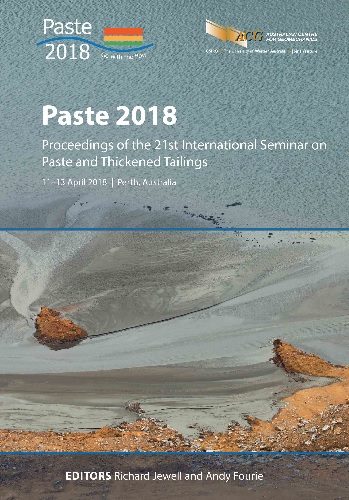Optimisation of paste thickening at the Yara Siilinjärvi plant

|
Authors: Ruhanen, E; Kosonen, M; Kauvosaari , S; Henriksson, B |
DOI https://doi.org/10.36487/ACG_rep/1805_06_Kosonen
Cite As:
Ruhanen, E, Kosonen, M, Kauvosaari , S & Henriksson, B 2018, 'Optimisation of paste thickening at the Yara Siilinjärvi plant', in RJ Jewell & AB Fourie (eds), Paste 2018: Proceedings of the 21st International Seminar on Paste and Thickened Tailings, Australian Centre for Geomechanics, Perth, pp. 75-88, https://doi.org/10.36487/ACG_rep/1805_06_Kosonen
Abstract:
The Yara Siilinjärvi plant is located in central Finland. The site consists of a mine, two sulphuric acid plants, one phosphoric acid plant, one nitric acid plant and one NPK fertiliser plant. The Siilinjärvi mine produces about 1 Mt of apatite concentrate, which creates approximately 10 Mt of tailings per year. At the beginning of 2017, tailings handling in Yara Siilinjärvi was brought into a new era, when the conventional tailings storage facility was replaced with a new tailings treatment plant. The new high-density tailings disposal system with two deep cone-type paste thickeners increased the percentage of solids in the slurry from 45–48% to 66–69%, making it possible to deposit as paste. This extended the lifetime of the current tailings storage facility by 15 years – from 2020 until 2035. The rheology of the tailings in Siilinjärvi is unique, due to the minerology of the slurry. In particular, the high content of coarse mica makes thickener operation challenging and makes high-density pumping sensitive to disturbances. Therefore, the importance of process control cannot be underestimated. An advanced control system is needed to maintain process stability and the desired operation point in varying running situations. This paper presents the results from applying a multivariable, optimising control strategy to two paste thickeners at the Yara Siilinjärvi plant. The presented solution is based on a separate advanced control tools (ACT) platform, and it can be cost-effectively utilised with any customer distributed control system/ programmable logic controller (DCS/PLC) system available. With the ready-made application package, implementation is straightforward, and only a minimal amount of system-specific tailoring is needed. The ACT system in Yara is highly integrated with the plant DCS, so that the operators have full access to the user interface, alarms, interlockings, history data and documentation through the DCS displays. Long-term follow-up shows that with the optimising control, the Yara paste thickeners can consistently run with underflow solids content of 66–68% to average beach slope angles of 3.5° (6.1%) in the tailings disposal area. Additionally, this control system facilitates the minimum use of flocculant, which means 10–20% savings in the flocculant costs. Robust thickener operation also leads to trouble-free high-density pumping and high availability of the paste plant.
Keywords: tailings, paste, thickening, process control, optimisation
References:
Aaltonen, J 2014, Thickened Tailings Plant Feed Parameters 2014, internal research report, Yara International, Siilinjärvi.
Bemporad, A, Morari, M & Ricker, NL 2015, Model Predictive Control Toolbox - User’s Guide, The Mathworks Inc., Natick.
Kosonen, M 2004, ‘Modeling and online control of paper machine wire retention’, PhD dissertation, Tampere University of Technology, Tampere.
Maciejowski, JM 2002, Predictive Control with Constraints, Prentice Hall, London.
Parker, B, Rivett, T, Backeberg, T, McIntosh, A, El-Masry, S & Heath, A 2016, Debottlenecking of Thickeners in a Changing Environment, Outotec Oyj, Espoo.
Paterson, AJC 2004, ‘High density slurry and paste tailings, transport systems’, Proceedings of the International Platinum Conference ‘Platinum Adding Value’, The South African Institute of Mining and Metallurgy, Johannesburg, pp. 159–165.
Ruhanen, E 2014, Thickened Tailings Pilot Plant, internal research report, Yara International, Siilinjärvi.
© Copyright 2025, Australian Centre for Geomechanics (ACG), The University of Western Australia. All rights reserved.
View copyright/legal information
Please direct any queries or error reports to repository-acg@uwa.edu.au
View copyright/legal information
Please direct any queries or error reports to repository-acg@uwa.edu.au



